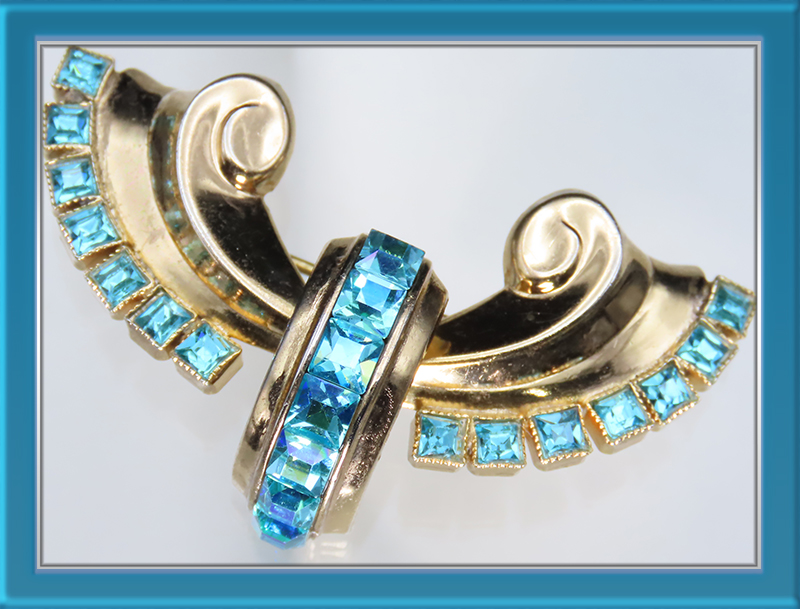Return To Previous Page
Coro
An unusual Coro brooch surely inspired by Horus Falcon from the Tomb of Tutankhamun. It is of very light metal with gold tone and in very good condition. The square Aquamarine rhinestones are spectacular and the pin back is in good working order. You will find the script Coro signature on reverse.
Julia Carroll explains in her book that most makers began to copyright rather than patent designs by 1955. However, Coro continued to patent designs through 1956 and sporadically after that. Coro seemed to go through a transitional period in 1955 and 1956. Some designs are patented and some are copyrighted. ID-422
Measurements:
Brooch — Approximately 2 1/8 inches wide by 1 1/4 inches tall.
Coro Jewelry History —
Coro founded in the late Twenties, was at one time the largest manufacturer of costume jewelry in the world, selling an incredible $33 million per year at their peak. The Coro name combined the first two letters of the last names of the founders, Emanuel Cohn and Carl Rosenberger. They had offices or plants in New York & Providence and at times they had a presence in Chicago, Los Angeles, San Francisco, Miami, Toronto, England and Mexico.
Adolph Katz was responsible for Coro's team of designers and for their marketing choices. Among his top designers was Selwyn Young, who contributed many of the outstanding 1940's designs, later joining the Lisner jewelry organization. Another designer was Anthony Aquilino, who later formed his own company, Anthony Creations. Others who contributed to Coro's designs were the Verrecchia brothers, Gene and Reno, who later founded GemCraft, still in business today in Cranston, Rhode Island.
Coro was the first major American manufacturer of costume jewelry to make double clips, which they soon became famous for their animal and floral "Duettes." Much sought-after, they have now become a collecting field in their own right. Clips were a mainstay of the 1920s jewelry, worn on furs or dresses to highlight an attractive feature, such as a lapel or plunging neckline. Coro came out with a version of the double clip on the heels of Louis Cartier after he patented the double clip. The initial designs were often Art Deco in style and decorated with pave-set clear rhinestones. Coro's greatest success, however, came with the creation of its figural Duettes and delicate trembler flowers mounted on springs.
Brand names, which were branches of the Coro network, were Vendome (which succeeded CoroCraft) and Francoise. Coro enterprises ceased operation in the 1970s. The family members who owned Coro stock sold 51% of it to Richton, Intl. Corp., who bought the remaining stock in 1970. Richton also owned the Oscar de la Renta brand. By 1979 all the Coro companies, except the Canadian company, were bankrupt. It was sold to a South American company in 1992, which also went bankrupt.
Having trouble with the small sizes of
yesteryear? Well, most of us do!
The ladies were smaller than the women of today.
NO Problem, be sure to check out our necklace extenders.
The ladies were smaller than the women of today.
NO Problem, be sure to check out our necklace extenders.




